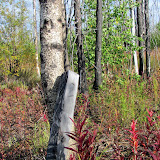I have been thinking about biking the Dalton Highway for several years now. The road has a legendary reputation for long 13% grades, epic mud, windshield- and tire-destroying rocks, and headwinds of doom – all of which of course makes it a very attractive road to bike. Things came together this spring, and in mid July I found myself driving up the Haul Road with Tom on a grand adventure. Some friends of ours were on a long float trip that ends up on a village near the north coast of Alaska where they would then fly to Deadhorse and drive back to Fairbanks. Luckly for us, they needed someone to drive their vehicle up to Deadhorse, so early on a Tuesday morning we loaded up our bikes and headed out of town. It was a long, uneventful drive up to Deadhorse and took a little under 12 hours including a shortish stop at Coldfoot. We spend the night at Deadhorse at the aptly named Deadhorse Camp hotel. The hotel was composed of a main building made of stacked ATCO trailers, with a number of stand-alone trailers on skis pulled up around the main building.

This is standard affair for Deadhorse – nearly every building not intended for equipment storage is composed of an ATCO trailer of one sort or another. Our room was in one of the trailers alongside the main building.

This was my first visit to Deadhorse in the summer. I had been here several times in the winter while passing though on the way to Barrow and things looked quite different when it’s not -40F with 50 mph winds.. Deadhorse is a strange place and fairly hard to describe. Its consists mainly of a immense series of gravel pads connected by gravel roads with all sorts of heavy equipment, oil exploration machinery, and trailers of all type parked in various stages of disarray, along with a couple of active oil and gas wells.

I stopped by the hardware store and picked up a set of tinted safety glasses, and then we headed out to find dinner. Most of the folks here are not full time residents and are here temporarily for work, either for short stints or on some sort of 2 weeks on, 1 week off rotation. This makes for some unusual living conventions, including the all-you-can-eat meal – all the restaurants in Deadhorse serve all-you-can-eat meals cafeteria style. The food is not bad, but not particularly exciting. We ended up eating at the Prudhoe Bay Hotel, and some of the clients definitely showed signs of the “all you can eat diet”. Eventually we pried ourselves away from the trough, though not before I made a to-go bag with a handful of pastries and headed back to our hotel to get some sleep.
In the morning we hopped on our bikes and were off!
Our route was pretty simple as there is really only one road option to get back to Fairbanks. We were going to leave Deadhorse, bike on the Dalton until it ended and then take the Eliot Highway back to Fairbanks. Fairly simple.
Here is an interactive map of our route:
View Larger Map
Day 1
For the first mile or so we had to bike some local roads to get to the Dalton. There was a surprising amount of traffic, though the drivers were pretty well mannered.

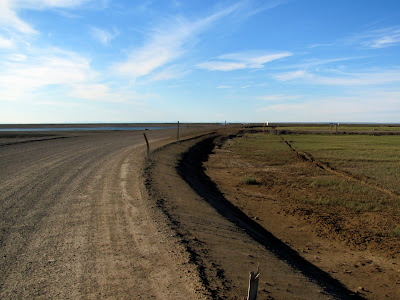
Eventually we reached the start of the Dalton, and our trip began!

The first 60 miles or so of the Dalton are mind-numbingly flat, but quite scenic. It might go without saying, but this section of our trip was quite far north – in fact I think this might be the farthest north you can go by road in North America. There are no trees this far north, just small willow looking shrubs and things that look much like grasses (I am obviously not a biologist). We really lucked out weather-wise – it warmer than I expected. We had a wonderful 65F weather, which was quite a bit nicer than the 40F I was expecting. The road surface for the start of our trip was hard packed dirt with a fair bit of calcium chloride mixed in to harden the road surface and to keep the dust down.
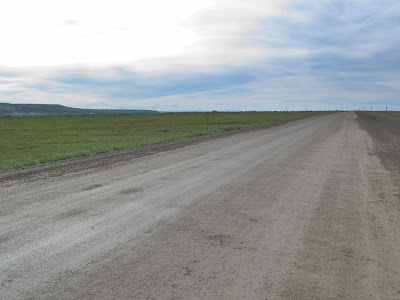
I had been told that there was a good chance that we might see some Musk Ox, but alas we didn’t. We did see a lots of birds and were dive bombed briefly by some shockingly large terns. We also saw a fair number of fat arctic ground squirrels, of which there was a lot.
At around mile 53 or so the surface changed to chip and seal and we enjoyed a nice break from the gravel road for another 27 miles.

Eventually the road surface switched back to dirt near a collection of dreary looking buildings called “Happy Valley”.
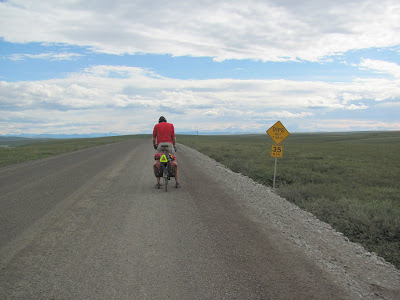
Just past Happy Valley there was a motorcyclist stopped in the middle of the road. It was a bit of a strange place to stop so when I caught up with him I stopped and asked if he was ok.

We talked for a bit and apparently he had stopped to take pictures, and was completely unfazed that he was in the middle of a dirt road with large semi bearing down on him from behind. I talked to him for a couple of minutes, learning he had driven his motorcycle up from Georgia. We saw an amazing number of motorcycles. It appeared that there were more motorcycles than any other type of private traffic on the road… not what I expected.
We continued biking until we reached the “Ice Cut”, a smallish hill where the road cuts through the a bluff and apparently exposed a large ice-lens, thus the name, and we called it a day. We camped on a pipeline access road that leads to the Sag River. The Dalton has lots and lots of wonderful campsites – at regular intervals there are side roads leading to the pipeline. The pipeline access roads are normally blocked by gates, but the gates are easy to get around or under with a bike, and as far as I know its fine to camp there so long as you do not block access.
Day 2
In the morning we continued, though the weather was a bit less sunny. We had brief rain showers for most the day, though it never rained very hard. For the first day the road was mostly very flat, with only an occasional small hill. As we traveled south we started hitting the foothills of the north side of the Brooks Range, and things became a bit less flat
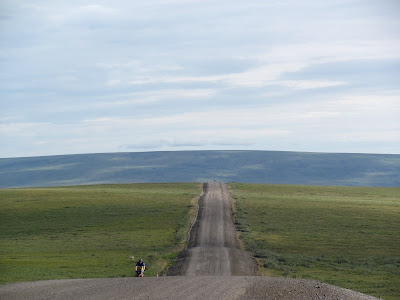
The hills continued to grow as we headed towards the Brooks Range and the high point of the trip, Atigun Pass.
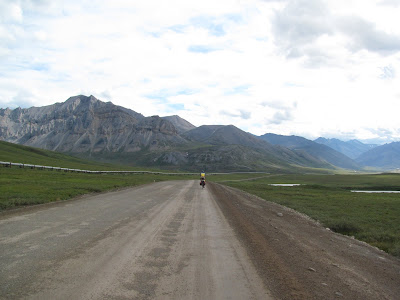
We passed a number of construction and DOT camps, including one with an interesting sign.
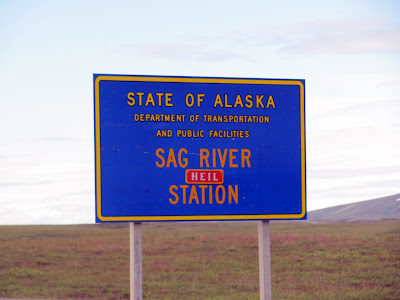
A little before we entered the Atigun River valley, we passed Toolik Field Station, where some neighbors of ours spend part of the summer studying the Arctic ecosystem.
 .
.
After passing the side road to Toolik, we passed Galbraith lake where some sort of massive excavation appeared to be going on, and started up the Atigun River valley.

The views were starting to be pretty nice at this point, but alas we were also on the receiving end of a stiff headwind. We spotted several groups of sheep sunning themselves on the other side of the valley.
On this section of road the trucks raised a fair bit of dust – fortunately the wind kept it from hanging around very long.

We did get to see some unusual cargo as the trucks drove by, including a rocket-shaped oversized load.

The Atigun River valley is quite beautiful and very scenic.

Eventually we reached the base of Atigun Pass, the only “big” climb of the trip, just in time for it to start raining in earnest.
Fortunately the rainstorm was short-lived, and by the time we were half way up the climb it had stopped raining.

The climb up the pass was a lot less of a climb than I was expecting – it is fairly steep but it is not that long and was over fairly quickly. At the top of the pass we were rewarded by wonderful blue sky and fantastic views of the south side of the pass – hurray!

From the top of the pass it was a wonderful ride downhill to our campsite for the evening near the airstrip at Chandalar Station.

We camped near the runway, but well off the section used by planes so we didn’t get in the way. The runway appeared to used only infrequently. The campsite had wonderful views of the Chandalar Shelf and the start of the Dietrich River valley.

Day 3
Our third day was pretty short, only a little over 50 miles and 4 hours of biking. We left pretty early, climbed up over Chandalar Shelf, and enjoyed a long downhill ride to Wiseman. We were starting to leave the Arctic and the vegetation was starting to change – we now had trees!

This section of the trip zoomed along, as it was mostly downhill with very few hills. About 10 miles or so before the turnoff for Wiseman the pavement started – nice new and fast pavement.
 .
.
We arrived in Wiseman a little before 3pm, with lots of time to explore, shower, do laundry, and get other random tasks done. We stayed at the Boreal Lodge a nice little lodge in Wiseman proper. I explored Wiseman for a short time, seeing the museum and an old general store, and walked around town a bit. Eventually I headed back to the lodge and spent a bit of time relaxing in the sun, and enjoyed several ice cream bars.
(2021 Update – I now highly recommend The Arctic Getaway in Wiseman – they are great folks and are bikers. https://www.arcticgetaway.com/ )
Day 4
On the forth day we headed out of Wiseman early and zoomed off to Coldfoot in an attempt to arrive in time to make the all-you-can-eat breakfast offering. We arrived with 15 minutes to spare, and quickly grabbed our food. Just as we were sitting down to gorge ourselves, the folks we shuttled the car for arrived. They had finished their trip a bit early and were heading back to Fairbanks. We had a very large breakfast with them, and eventually hit the road again, powered up (or slowed down) by the massive quantity of food we had we had eaten. The road south of Coldfoot is paved and was fast riding. A little south of Coldfoot we ran into our first biker (while on bikes anyway – we saw several bikers on the drive up, but as we were driving it does not count) of the trip – Rucker.
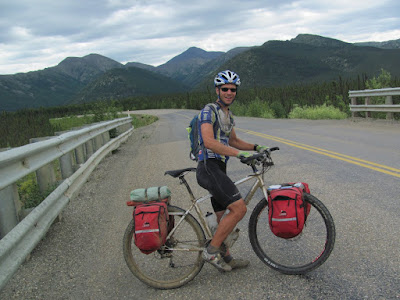
Rucker is from Ohio and is apparently friends with the cousin of one of my neighbors, who asked if we had seen him. Sometimes it is an amazingly small world.. We saw a handful of bikers on the drive up to Deadhorse, and two bikers on the bike ride back to Fairbanks, and Rucker was the only one who seemed to have things in order, and appeared to be carrying a reasonable amount of stuff.
The road south of Coldfoot is very scenic..

We stopped for at the Arctic Circle for a quick photo..

and made a quick pass though the campground looking for “bucket man”. On the drive up we passed a fellow biking in full bug gear with 5 gallon buckets instead of panniers. I thought about stopping to say hi and ask how the biking is, but since we ran into him around 10 miles or so outside Deadhorse I thought I would just catch up with him the next day. Alas, bucket man was hauling butt, while we kept an eye out for him we didn’t catch up with him until the Arctic Circle campground, where he was sleeping, so we didn’t get a chance to talk. I did admire his bike from a distance however.

The only major climb of the day was Beaver Slide.

Beaver Slide is a 9% grade gravel hill that is about two miles long and very straight. As we approached it I saw huge white ghost-like shapes descending it in an ominous manner. Fortunately they turned out to be wide load trucks with huge white boxes on them.

Climbing Beaver Slide turned out to be an amusing exercise in dust and bad driving. The truckers seem to take the hill pretty slowly, going up and down the hill at a reasonable rate. Alas, some of the private traffic seems to think this is a ideal place to pass, and we witnessed several very marginal passing maneuvers while climbing the hill. It was very dry when we were on this section of road, which ment it was very dusty. Fortunately it is only two miles long and it goes by fairly quickly.

The rest of the day went by fairly quickly. We biked until Dall creek, where we took a pipeline access road and camped under the pipeline.

The pipeline was amusingly adorned by lots of notes and a few strange symbols.

Disturbingly, one of the pipeline supports we camped under was labeled “Replace S Bracket”. We did survive the night.

Day 5 – the day of Mud!
The next morning we awoke to a light rain. We packed up and headed with with plans of getting an early morning burger at Hot Spot, a burger joint several miles from the Yukon River. The road quickly turned to dirt again, but it was not a big deal as it was not raining all that hard. This was going to change however…
The section of road before the Yukon River is scenic with wonderful sections of fireweed in old burns – quite beautiful.

For most of the morning there was a light rain, and it was starting to make the road a bit muddy.

Eventually we arrived at Hot Spot and had some burgers. After the burgers we headed out. While we chowed burgers it had continued raining, and as a result the road was a bit more muddy..
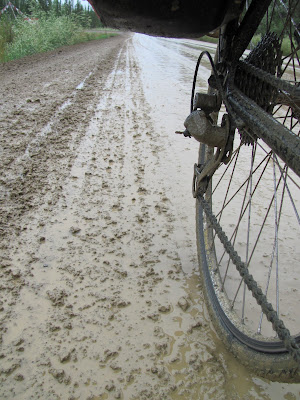
We stopped briefly at Yukon River camp and I grabbed two Dr Peppers and we then headed across the bridge over the Yukon River. The Yukon River bridge is pretty funky – it is the only bridge I have crossed with a definite slope to it. Biking up hill on a muddy wood decked bridge in the rain is an interesting experience.

The mud got progressively worse…

Fortunately we were saved by a brief bit of pavement after the bridge. While we were on the pavement we passed a fellow biker from Holland via Canada who was hauling a lot of stuff – a fully loaded B.O.B. and a full set of panniers, and was carrying food for full 14 days. It looked painful. Eventually the pavement ended and the mud began again. By this time the rain had stopped and things were drying out, but while the road was getting better the semi-dry mud was very sticky and our bikes required frequent de-mudding.

Eventually we had to stop at a creek and did a complete de-mudding and ate dinner while the road dried out. This worked wonderfully, as by the time we had finished and were ready to go the road was much dryer and almost mud free.
With about 10 miles left on the Dalton we ran into a fellow walking on the side of the road. We stopped and talked for a bit, and learned he was on day one of an attempt to Dalton Highway from the junction of the Elliott to Deadhorse. He was from Worcester, MA and was figuring on taking 18 days.
We biked the rest of the evening, and made it to the Elliott highway, which marked the end of the Dalton – hurrah!

We biked for another hour or so and made it to Fred Blixt cabin, which we had rented in case we wanted to spend the night there. It had been a bit of a long day and we were pretty happy to crash at the cabin.
Day 6 – the last day!
The final day was fairly short, but has a few hills. We got an early start and stopped at Joy, a small homestead and gift shop, grabbing a bite to eat. Several hours later we made it to Hill Top, a local truck stop at mile 5 of the Elliott, and dropped in for a (large) bite to eat. I had some pancakes and Tom enjoyed a burger. I was warned the pancakes were huge, but was not expecting the massive too-big-for-the-plate pancakes that I ended up with – alas I was only able to eat half of them. The rest of the trip was pretty mellow, though it was a bit hard to bike with so much food inside me. I made it back to my house at around 4 or so, just in time to meet up with my wife Nancy and the twins returning from picking up their veggies from the local CSA.
For those interested, here are our final stats for the trip:
- Day 1, Deadhorse – Ice Cut: 92.5 miles, 8 hours
- Day 2, Ice Cut to south side of Atigun Pass: 85.8 miles, 8 hours
- Day 3, Atigun to Wiseman: 54.1 miles, 4 hours
- Day 4, Wiseman to Dall Creek: 104 miles, 8:30 hours
- Day 5, Dall Creek to Fred Blixt: 101.5 miles, 9:30 hours
- Day 6, Fred Blixt to Tom’s house: 75.9 miles, 6 hours. +~3 miles for Jay.
- Total, 513.8 miles, 44 hours
Notes for other folks interested in biking the Dalton Highway.
- Food is available at several places along the road:
- Yukon River Camp, MP 56
- Hot Spot and 5 mile Camp, MP 60
- Coldfoot, MP 175
- Wiseman, MP 186
- Deadhorse, MP 414
- All these places (except Wiseman) have diner style food, and a selection of very basic snacks.
- The Arctic Getaway in Wiseman is highly recommended as a place to stay in Wiseman – they are great folks and are bikers. https://www.arcticgetaway.com/
- There is a post office in Coldfoot, so it is posssible to mail stuff there to be picked up, though the office hours are a bit strange – Mon,Wed,Fri 1:30-6:00pm
- With all these options for food it’s silly to carry all the food for the entire trip with you the whole time. Unless you love hauling extra weight up and down the hills.
- If you book a reservation with one of the places to stay along the road, its probably possible to mail them a food drop of some sort. Ask first of course.
- There are quite a few hills – go as light as is reasonable.
- Basic cross tires in the 32-40mm range with a little bit of tread are fine. Bigger tires will add more comfort but slower riding, smaller tires more suffering.
- If the road is muddy and it looks like it might stop raining, take a break and let the road dry out. The road appears to dry pretty fast and the daylight hours are long. Go take a nap!
- Fenders are a very good idea – not only for keeping you dry, but for keeping your drive train as clean (as possible anyway) of mud. If it rains there will be mud.
- No bike repair stuff can be found on the Dalton, though there is a very well stocked hardware store in Deadhorse that might have some things (patch kits for example)
- You can’t bike to the Arctic Ocean. You can take a tour there and listen to a talk about how clean and happy BP is, and splash in the ocean if you want, but you cannot bike there.
- Bring at least one water treatment system! There is lots of water in streams and lakes along the road, but pretty much all of it needs treatment unless you want giardia or some other friendly gut nasties. We used an older model of the Steripen with backup chlorine dioxide pills and two part chlorine dioxide liquid. Treating water is fast and safe these days, there is no reason not to do it. The walker we ran into at mile 10 was planning on drinking untreated water for the most part, which I hope works for him, but for most people will end up with the “Giardia Weight Loss Plan” and an potentially aborted trip.
A simplified map of the route:
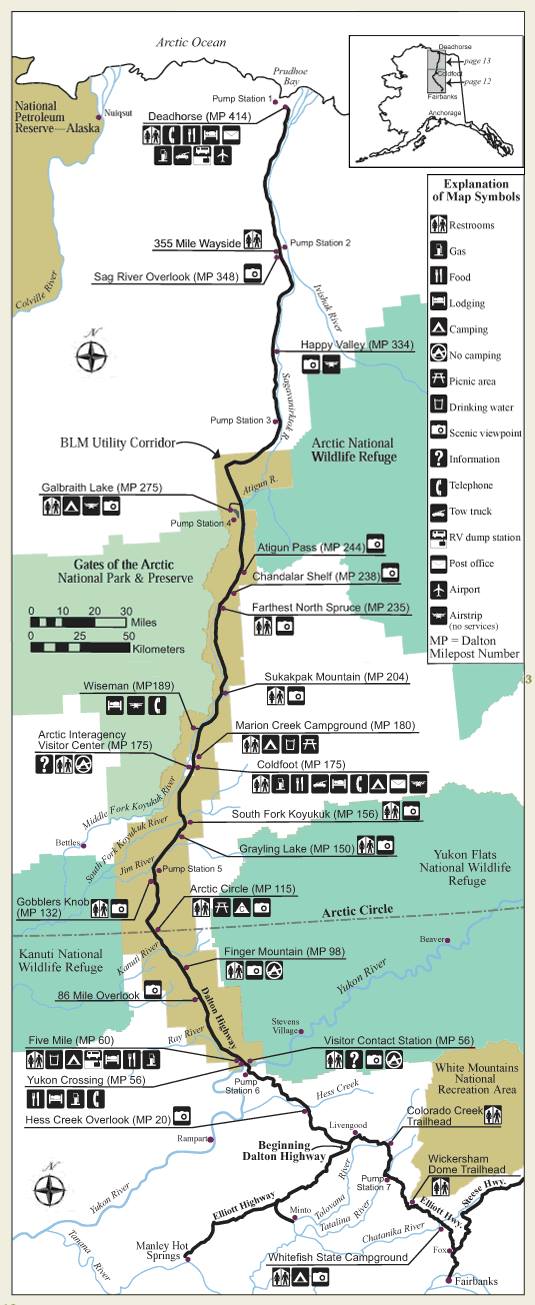
More Photos can be found Here.




